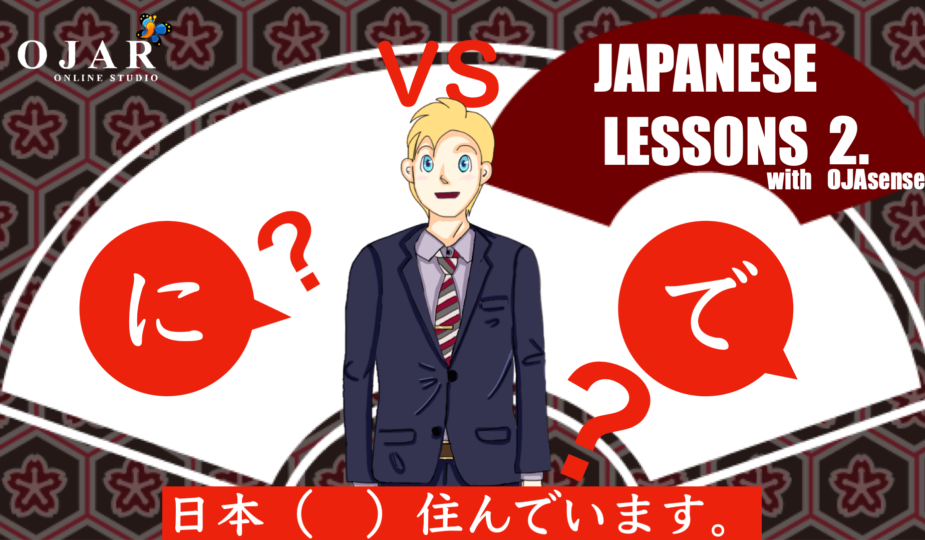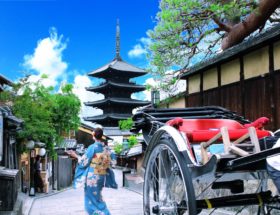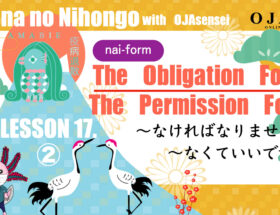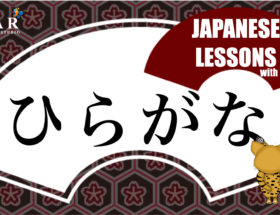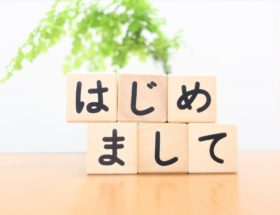Though particle is just ONE word, it might define your Japanese fluent whether you can use particle correctly or not. I recommend you to learn with illustrations and example sentences to identify the difference between particle ni and particle de easily and effectively.
I’m going to show you illustrations with funny OJAR friends and example sentences here! Let’s master the usage of particle ni and particle de and Japanese which surprises Japanese people!
Let’s get started!
A Dictionary of Basic Japanese Grammar
| Amazon Reviews: | ★★★★★ |
|---|
Publisher: JAPAN TIMES
CONTENTS
Particle ni VS Particle de
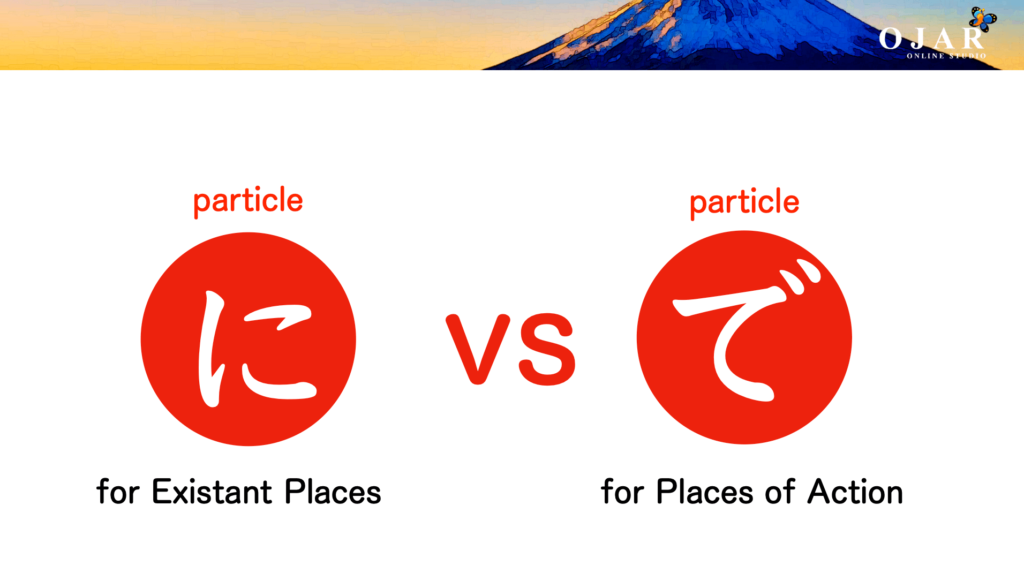
“に ni” mainly shows “an Existent Place”. While “で de” mainly shows “a Place of Action”. There are a lot of usages of “particle ni” and “particle de”.
I’m going to shows usages of “particle ni” and “particle de” with the most common verbs in the last part.
■ に and で Follow Nouns!
I’m going to tell you what are particle ni and particle de here.
“に ni” and “で de” are particles, called “格助詞
Kakujoshi always follows A NOUN and shows what kind of
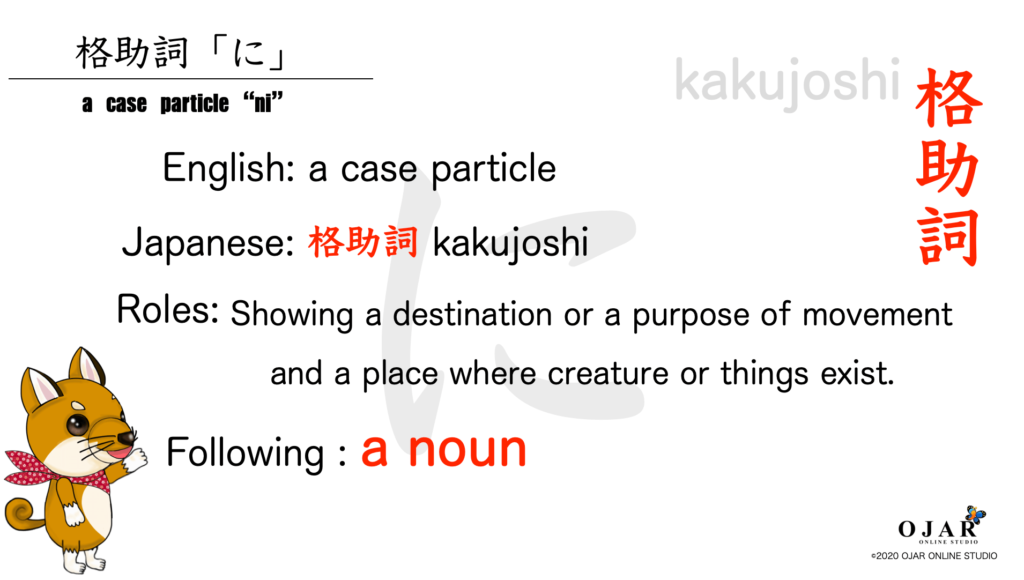
Memorize these particles follow NOUNS! It’s not verbs, adjectives, and so on. That’s a really important tip not confusing with te-form で.
■ Tricky に of Adverbs
Japanese adverbs are often added “に ni” the end of the word.
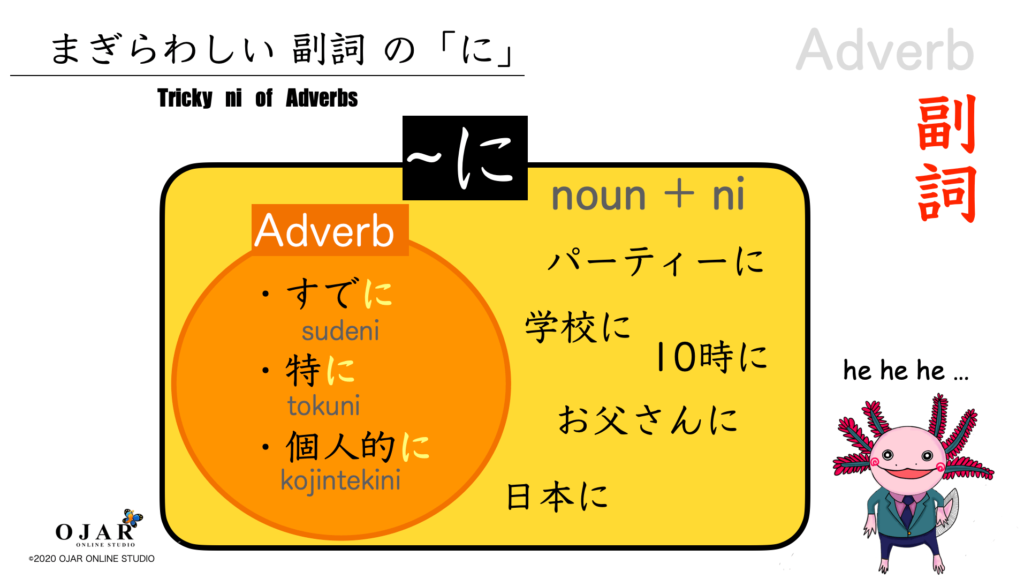
It’s like a “-ly” in English.
Usually, these adverbs can’t divide into a word and particle ni. Japanese textbooks tell that we can’t understand what the meaning of the word is if you divide into the word and ni like; すで + に, as one of the characteristics of adverbs. (Actually, many adverbs are understandable though…)
Learn these words as ADVERBs when you learn Japanese. Be careful!
■ Tricky で as te-form
Some people are confused with で as te-form.
People who beginners’ level of Japanese are sometimes mistaken like;
“If it follows います or あります, it should be used に”.
But it’s a dangerous idea.
Actually, The sentence like a “There is / are -.” often translates into “~に あります。/ ~に います。”. But don’t forget about “te-form で”.
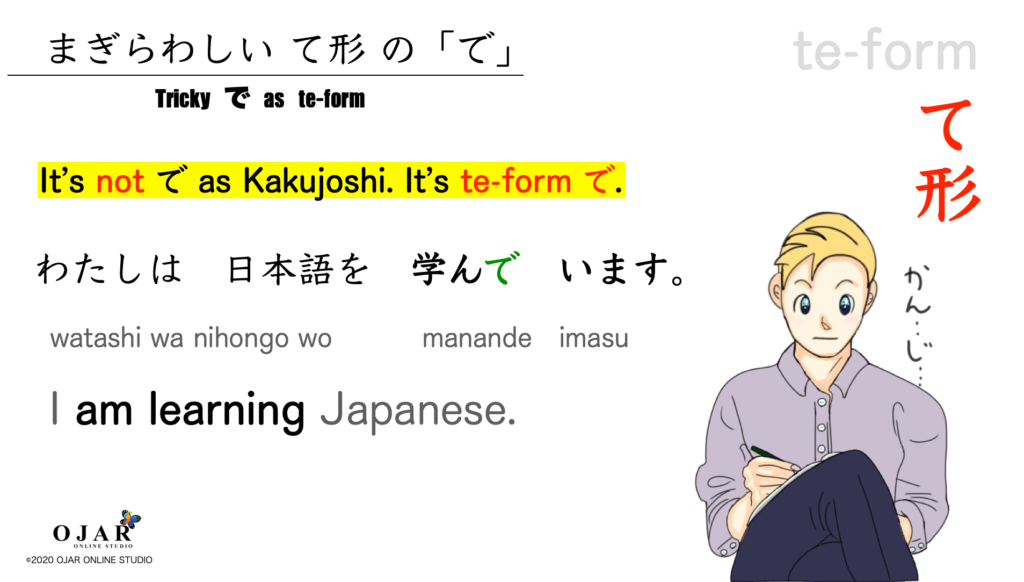
It’s the present progressive form “ is / am / are + -ing”.
This “で de” is te-form because follows the verb “学ぶ”. It’s NOT a noun. So it’s not で as Kakujoshi. (I’m going to tell you how to use で later. )
If you want to know how to use で as te-form, you can learn from HERE!
How to use particle に?
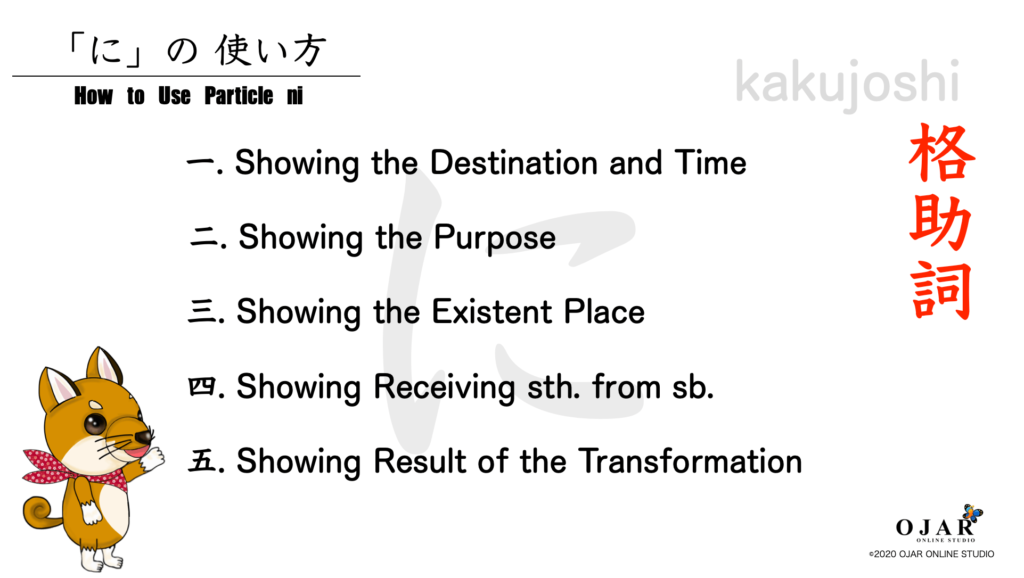
Particle ni can show destinations and and places where creature or things. It is mainly used with action verbs and plays a role as “to” or “at” in English. There are 5 usages using “に ni”.
1. Showing the Destination and Time
“に ni” can show the destination or time. It is mainly used with action verbs and is the same as “to” or “at” in English.
・Destination
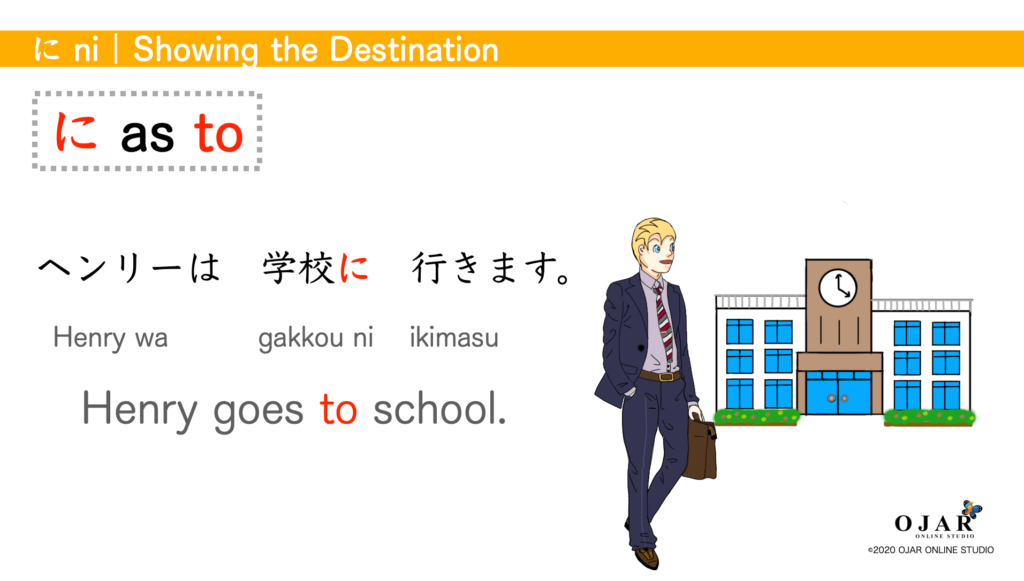
・Time
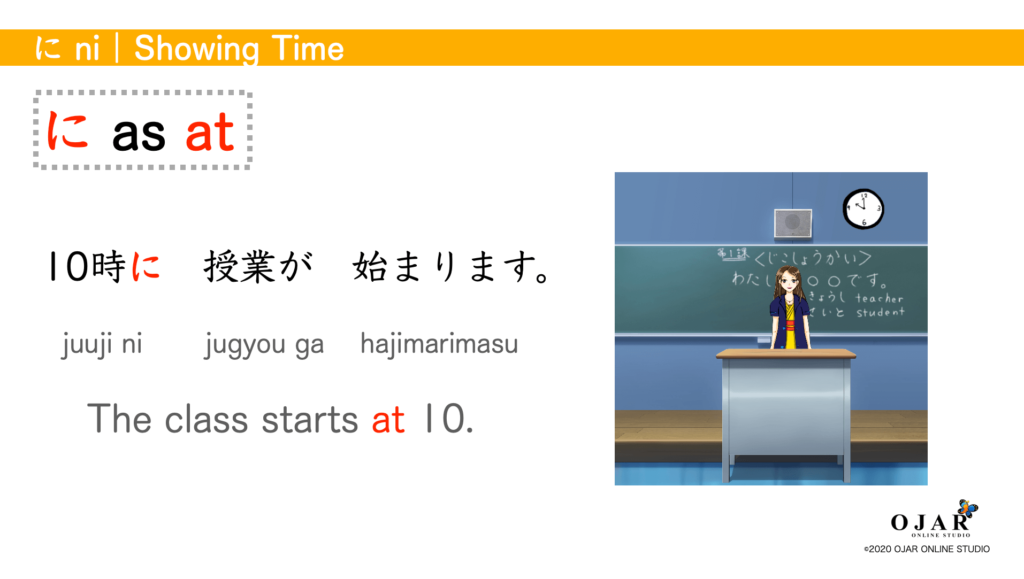
2. Showing the Purpose
“に ni” can show the purpose of the movement. It is mainly used with action verbs and plays a role as “in” or “at” in English.
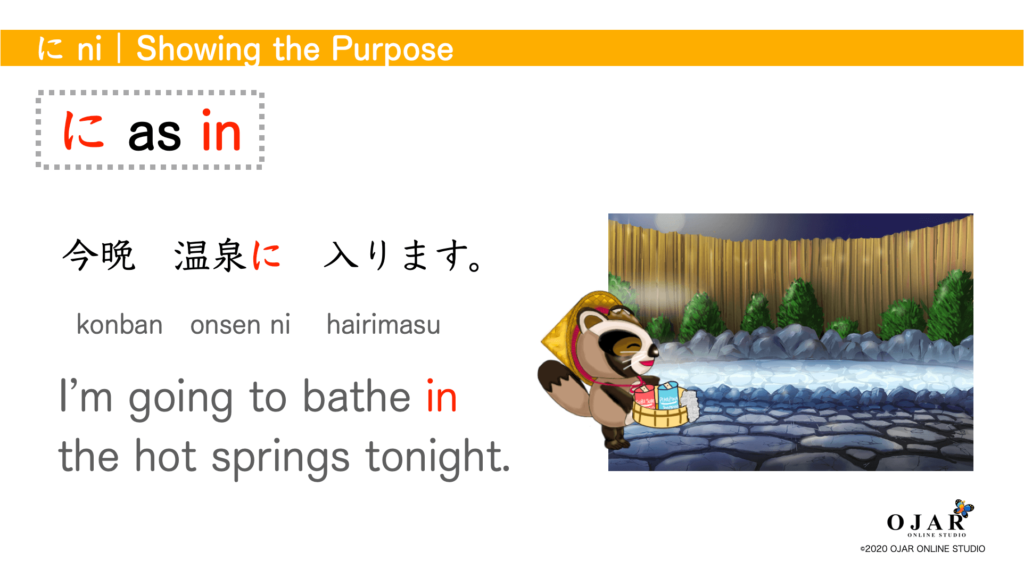
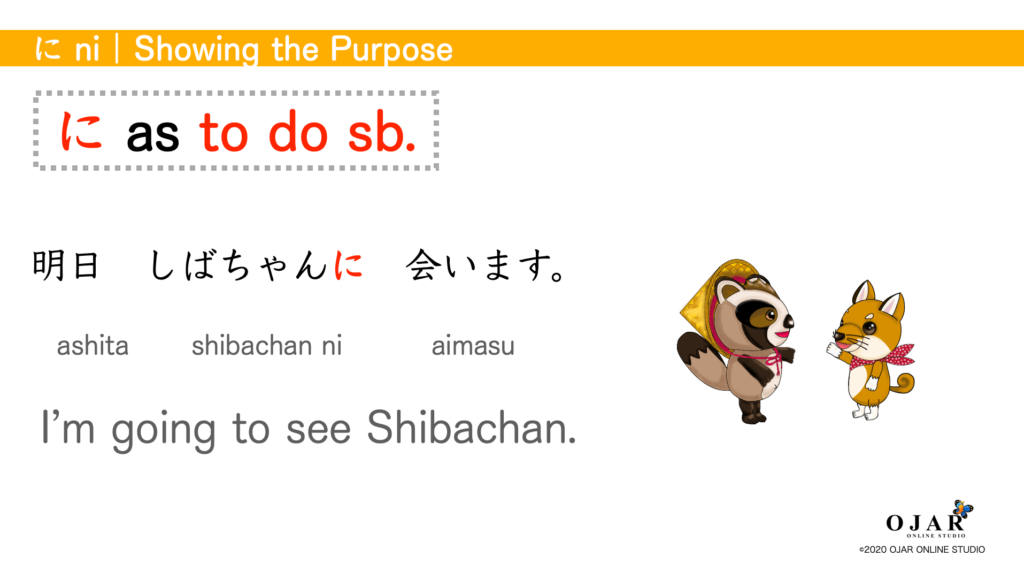
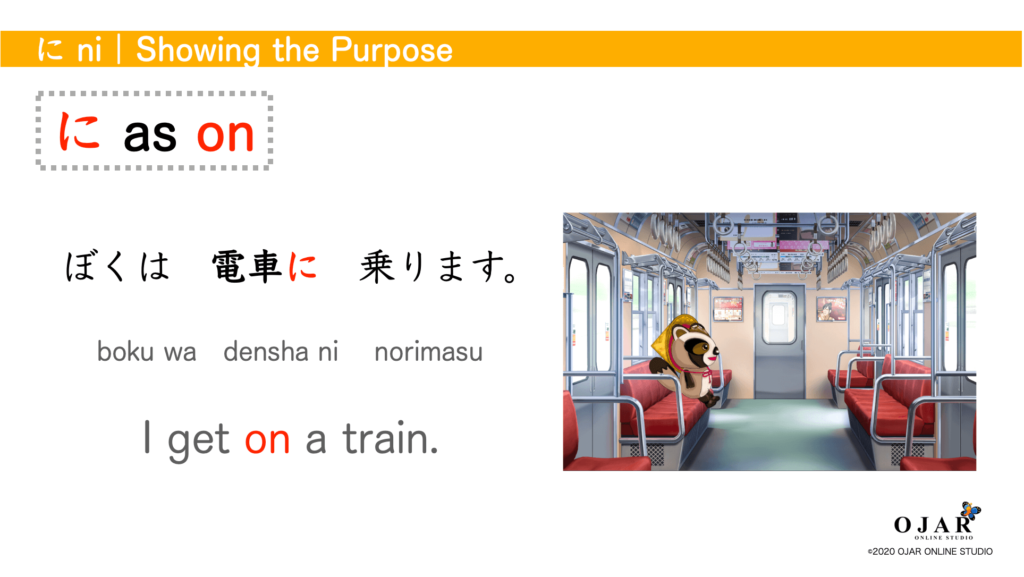
3. Showing an Existent Place
“に ni” can show a place where creatures and things exist. It is mainly used with action verbs and the same as “in” or “on” in English.
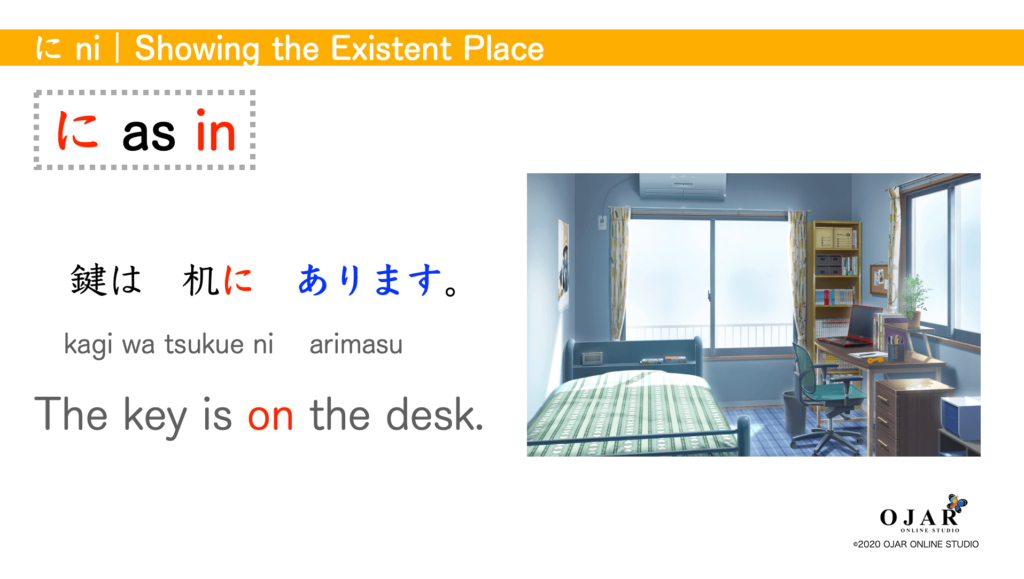
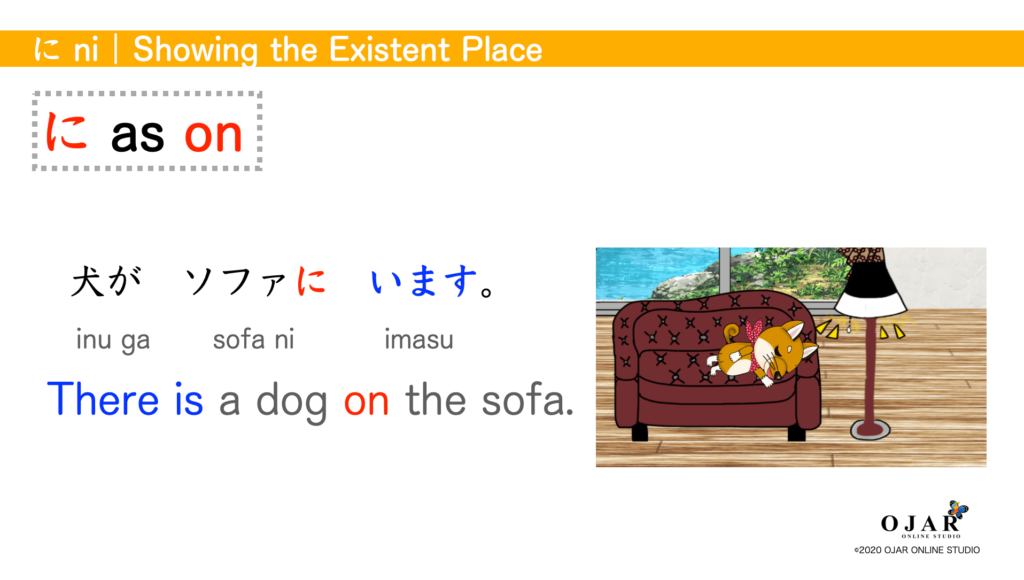
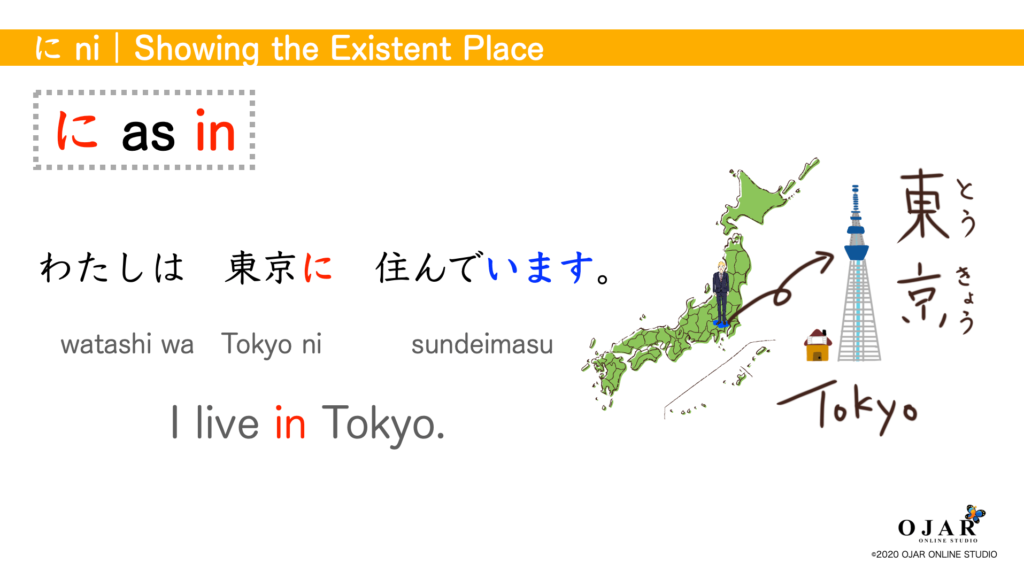
⚠️ Common mistake:
東京に 働いています。
When you want to indicate the place where you are active, you have to use “で de”.
4.Showing Receiving sth. from sb.
に can show receiving something from somebody or is used in the passive voice. It is mainly used with action verbs and plays a role as “by” or “from” in English.
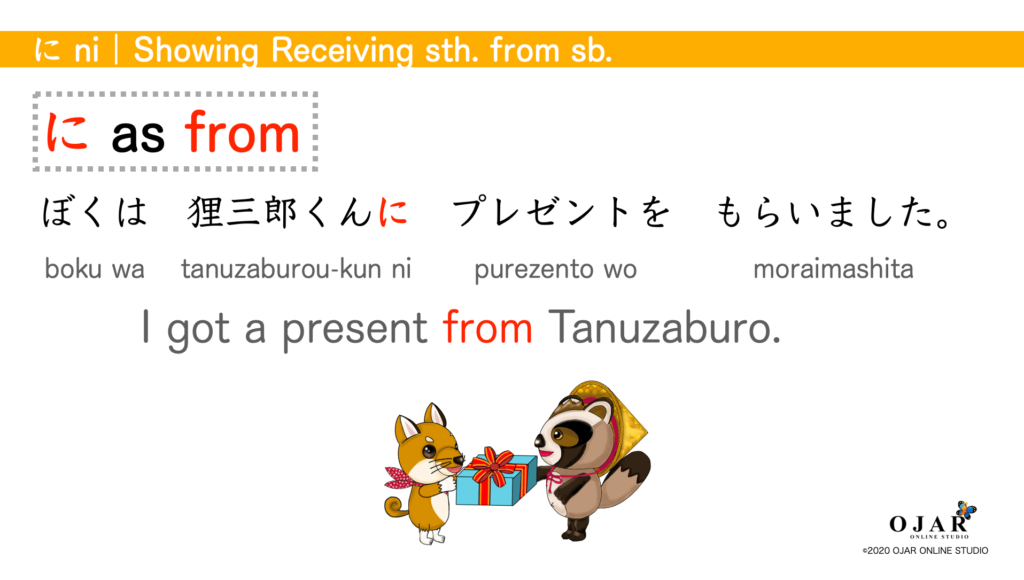
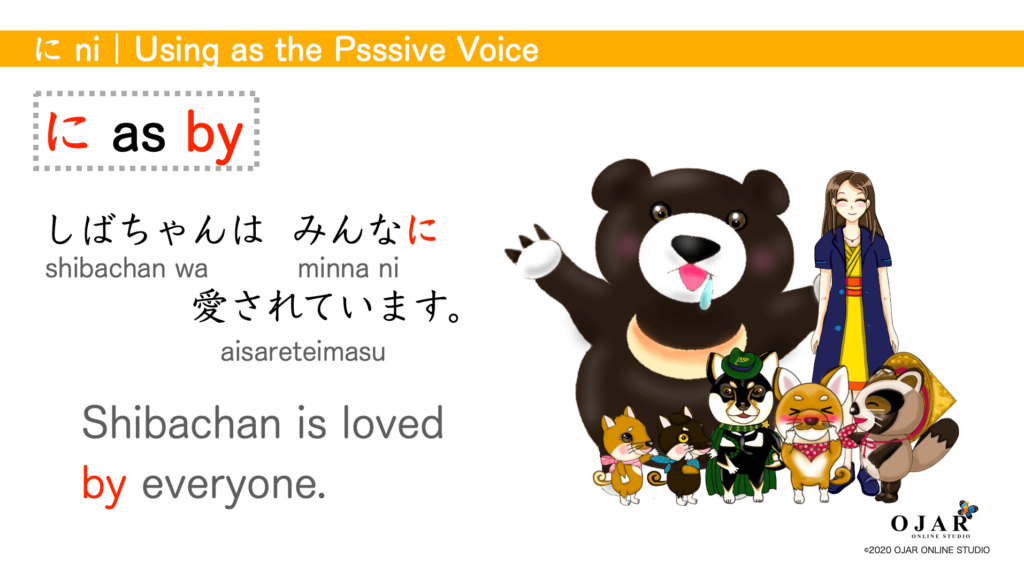
You can use “から kara” for “に ni” as a substitute.
5. Showing the Result of the Transformations
Also, に can show the result of the transformations.
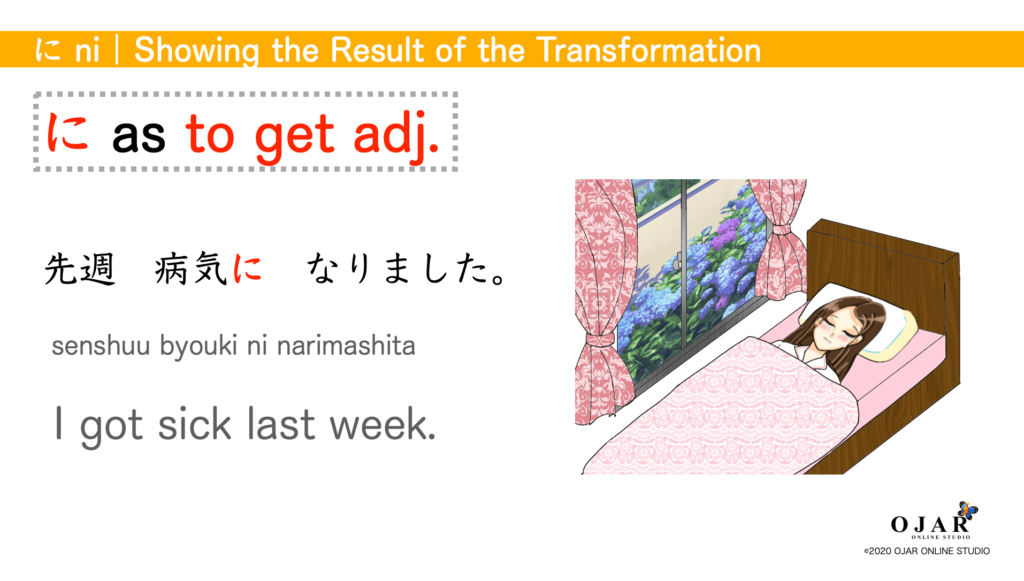
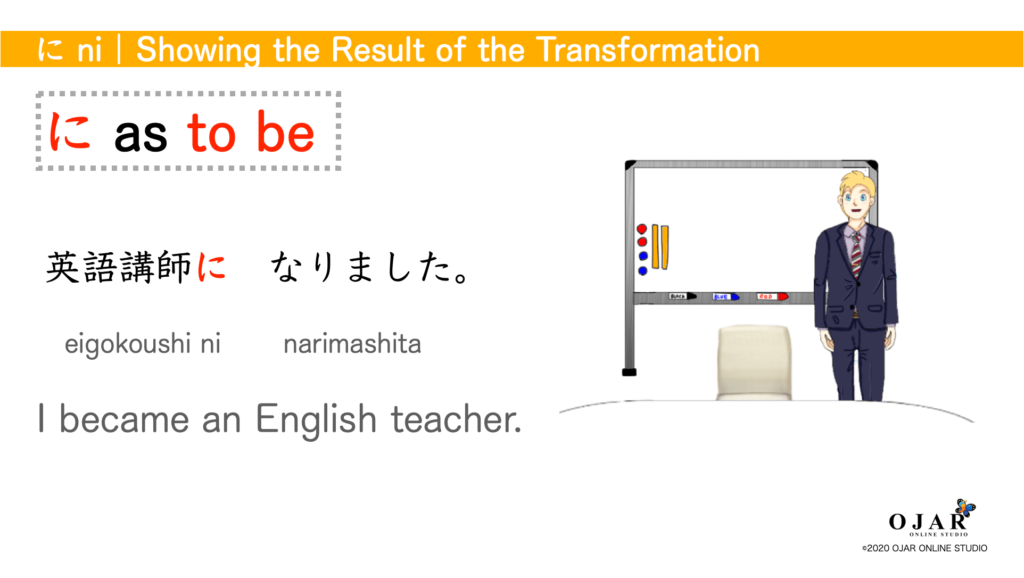
■ The Nouns Following に
These nouns are following “に ni”.
| Japanese | English |
|---|---|
| ~時代 jidai | – era |
| ~時 ji | – o’clock |
| ~日 nicht / hi/ bi | – day |
| ~中 chuu / naka | by – / until – |
| ~の間 no aida | period |
日曜日に 会いましょう。
nichiyoubi ni aimashou
Shall we meet on Sunday?
わたしは 午前中に 仕事を 終わらせます。
watashi wa gozenchuu ni shigoto wo owarasemasu
I will finish the work by this morning.
You can use“までに madeni” for “に ni” as a substitute.
・The Nouns Not Following に
You should not use particle に with these nouns. Even Japanese people use them with ni and we can understand what you want to say. But it’s unnatural a little for us.
| Japanese | English |
|---|---|
| 今年 kotoshi | this year |
| 来年 rainen | next year |
| 去年 kyonen | last year |
| 今月 kongetsu | this month |
| 来月 raigetsu | next month |
| 先月 sengetsu | last month |
| 今週 konshuu | this week |
| 来週 raishuu | next week |
| 先週 senshuu | last week |
| 今日kyou 本日honjitsu (formal) | today |
| 明日 ashita (casual) / asu (formal) | tomorrow |
| 明後日 asatte | the day after tomorrow |
| 昨日 kinou (casual) /sakujitsu (formal) | yesterday |
| 一昨日 ototoi (casual) / issakujitsu (formal) | the day before yesterday |
| 毎日 mainichi | every day |
| 今朝 kesa | this morning |
| 今晩 konban | this evening |
| 昨晩 sakuban | last night |
| ⭐️午前中 gozenchuu | in the morning |
| 今 ima | now |
| さっき sakki | a little while ago |
| ⭐️長い間 nagaiaida | for a long time |
| ⭐️5年間 gonenkan | for 5 years |
| いつ itsu | when |
| いつも itsumo | always |
今年 結婚しました。
kotoshi kekkon shimashita
I got married this year.
午前中 日本語の 授業を 受けました。
gozenchuu nihongo no jugyou wo ukemashita
I took Japanese lessons in the morning.
if you add “に ni”, we hear like “I took Japanese lessons until this morning.”.
⭐️ So be careful for “~中 chuu” or “~の間 no aida” of nouns.
How to use Particle で?
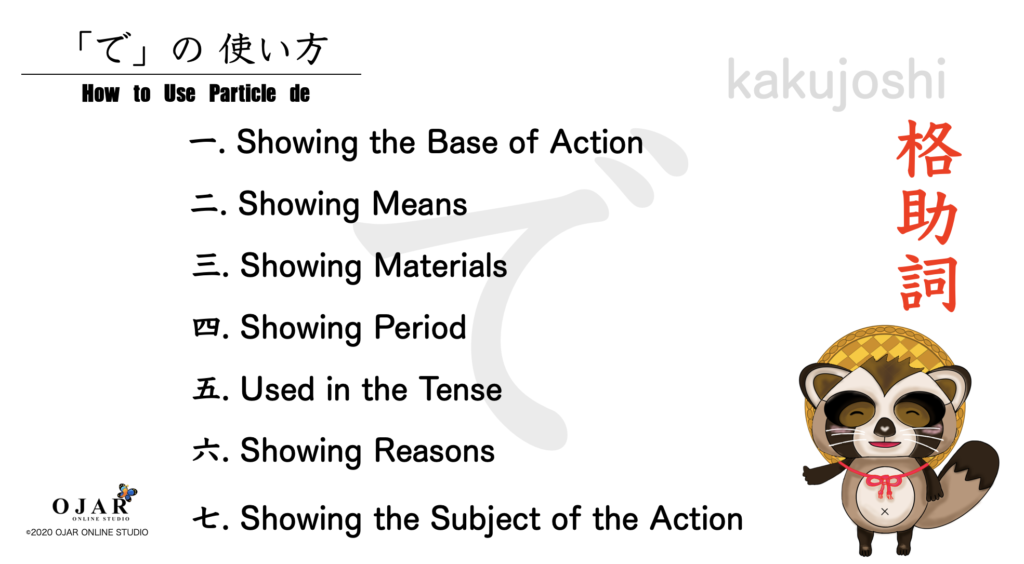
Particle で is also kakujoshi and always follows a noun.
Particle で can show the base of action, means, and is used in tenses etc. It plays a role as “at” or “with” in English. Here is 7 tips to how to use “で de”.
1. Showing the Base of Action
It can show the bace of activition. Action is important in this topic. So it doesn’t include existent places like “住む to live (in place)” or “いる to stay (in place)”etc. It the same as “at” or “in” in English.
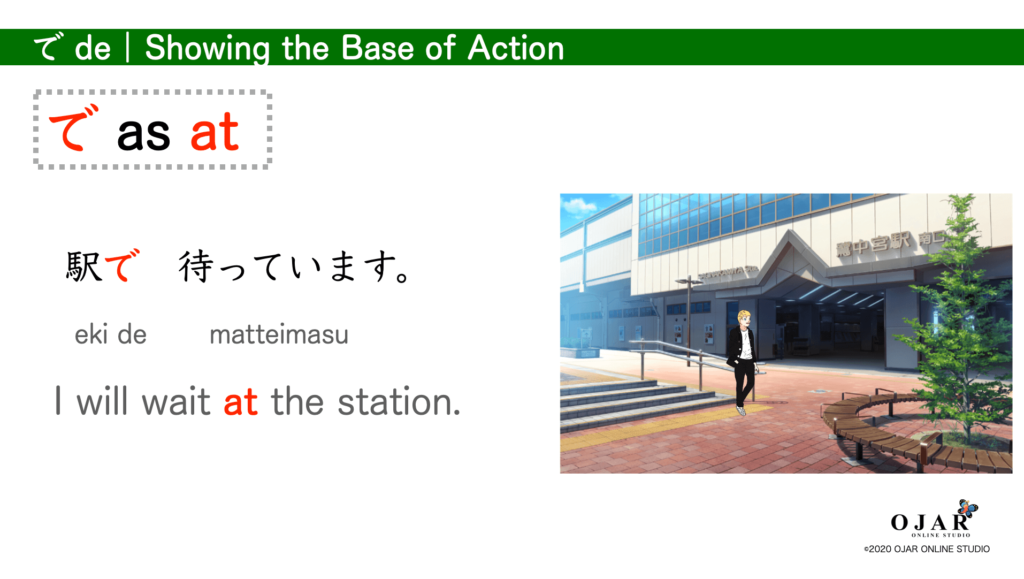
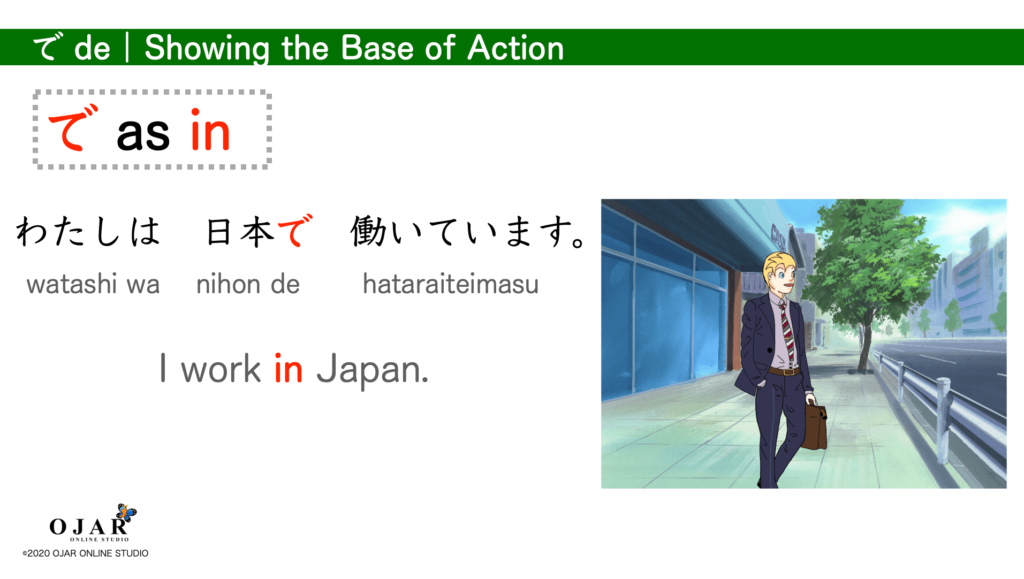
2. Showing Means
It can show means. It the same as “with sth.” or “in language” in English.
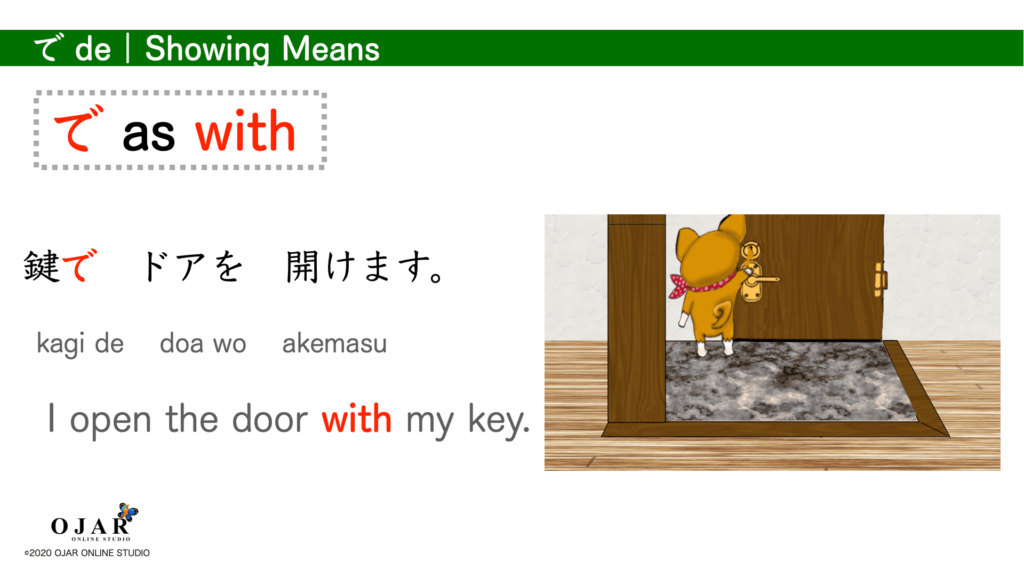
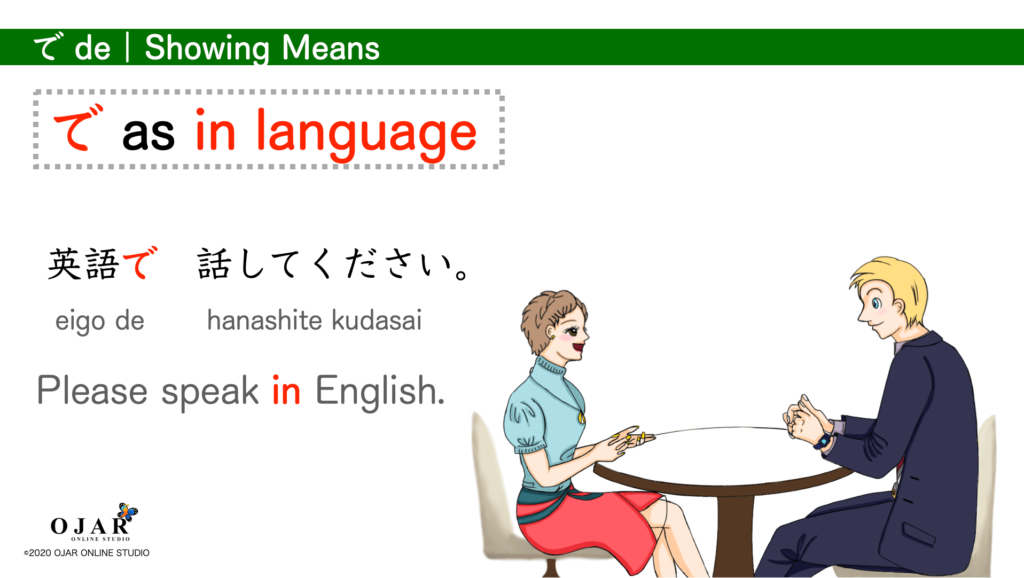
3.Showing Materials
It can show materials or ingredients in the things. It is the same as “ to be made from sth. / to be made of sth.” in English.
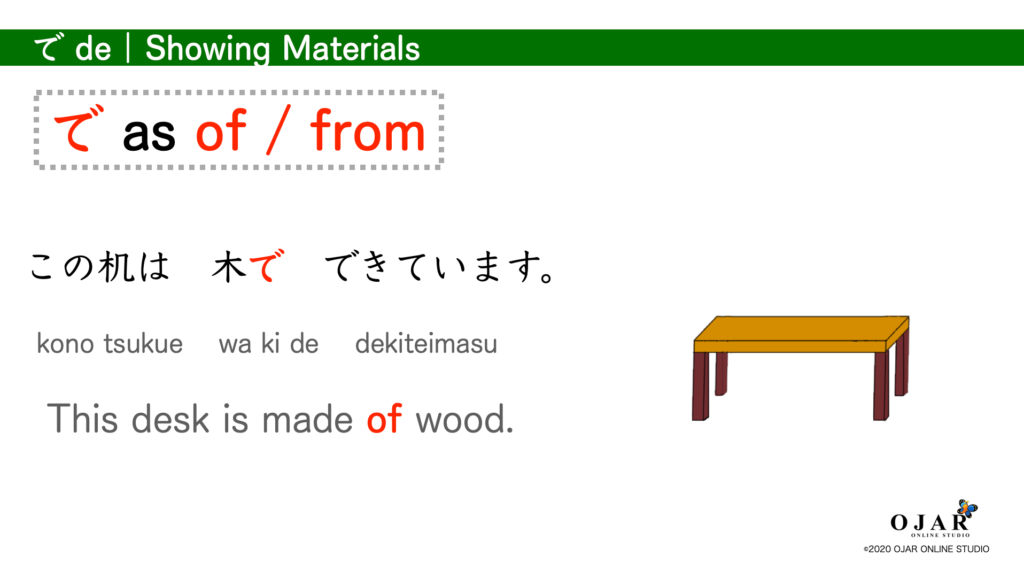

4. Showing Period
It can show a period. It is same as “in” in English.
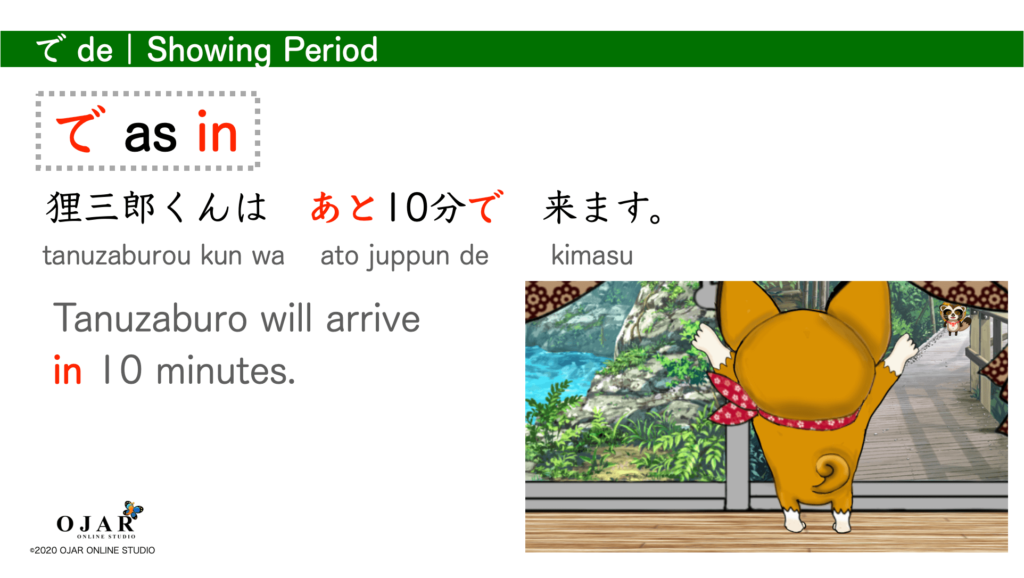
5. Used in the Tense
で is used in the future tense, the perfect tense, or the past tense t as the point of the time. It is the same as “to be made from sth. / to be made of sth.” in English. It indicates the time when the event will occur or in the future or has already happened in the past.
・The Future Tense
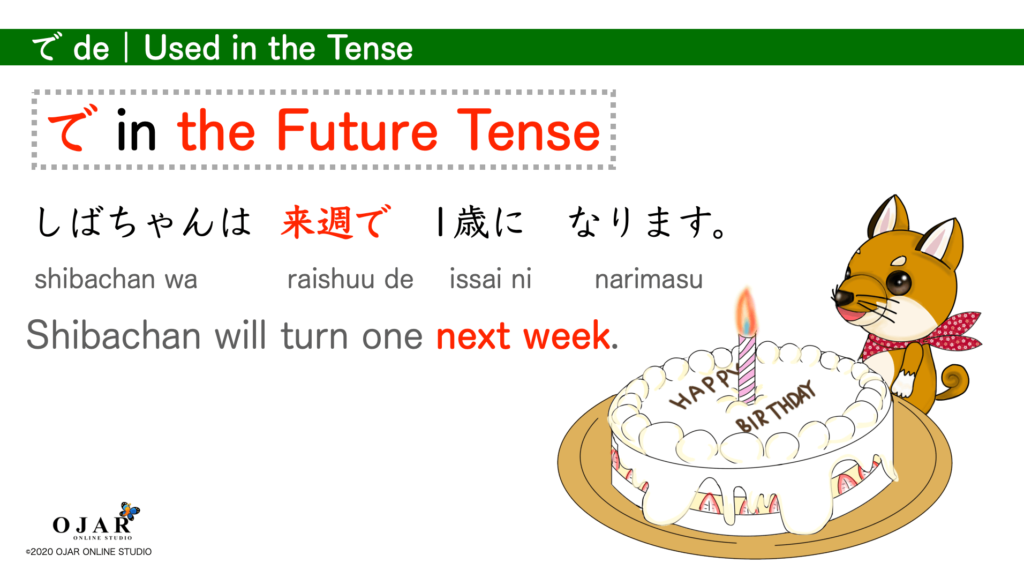
You can also say;
しばちゃんは 来週 1歳に なります。
But if you add “で de” in this sentence, you can empathize “来週”. Or we sometimes try not to use kanji+kanji like “来週一歳” because it’s hard to read.
・The Perfect Tense
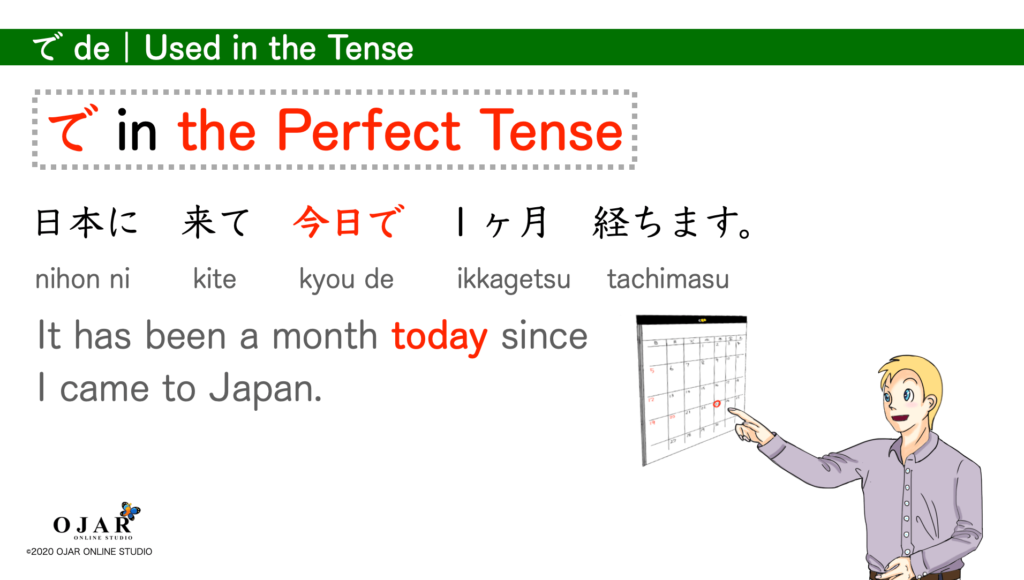
⚠️ You can not omit “で de” in this case;
日本に 来て 今日 1ヶ月 経ちます。
You need to empathize the point of the time “今日”, it’s not yesterday or tomorrow.
・The Past Tense
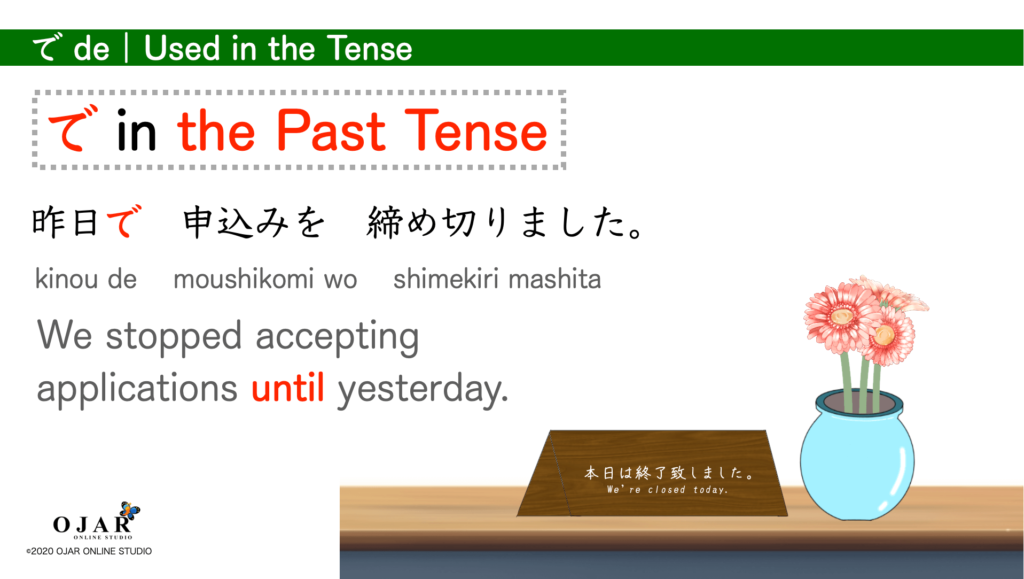
You can use “までで madede” for “で de” as a substitute.
6. Showing Reasons
で can show negative or positive reasons. It is the same as “because of” or “thanks to” in English.
・For Negative Things
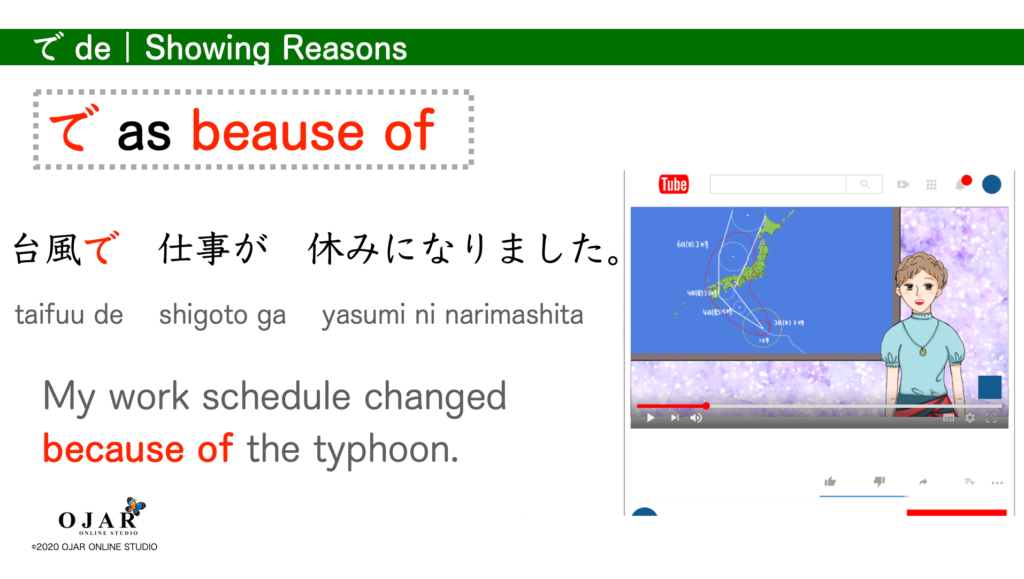
You can use “のせいで no seide” for “で de” as a substitute.
・For Positive Things
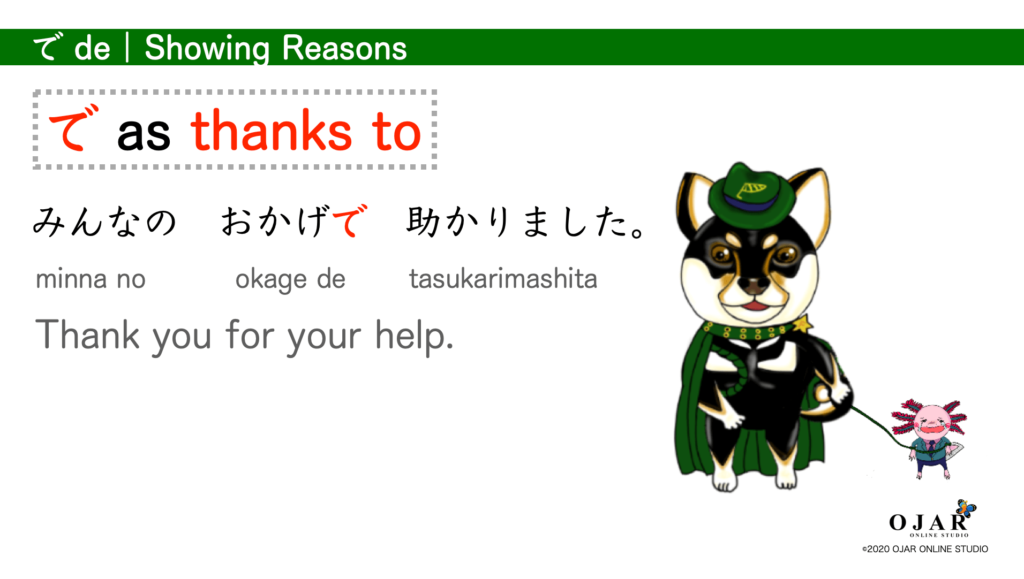
You can use “のおかげで no okagede” for “で de” as a substitute.
7.Showing the Subject of the Action
で can show the subject of the action. It is same as “alone” or “-self” in English.
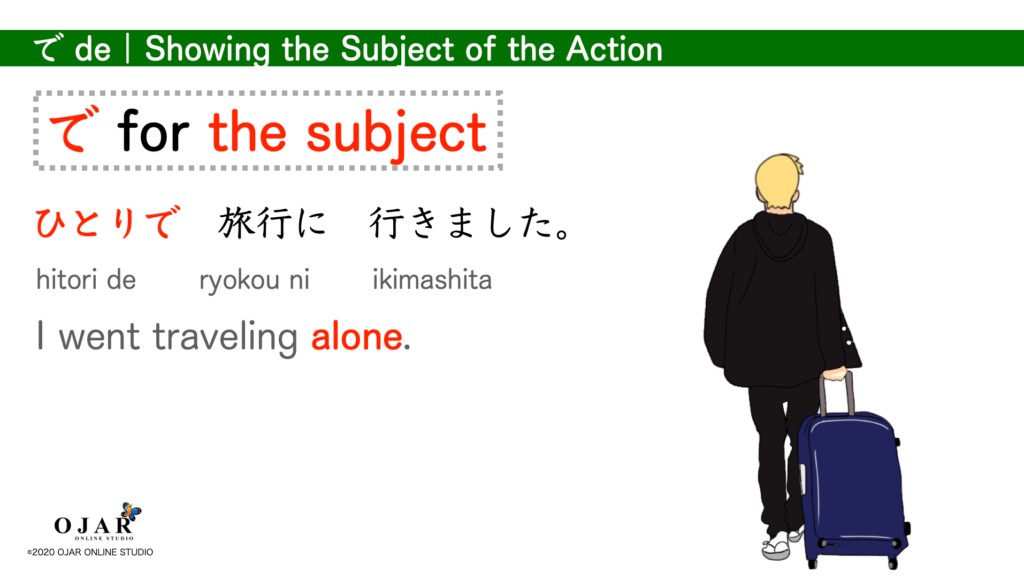
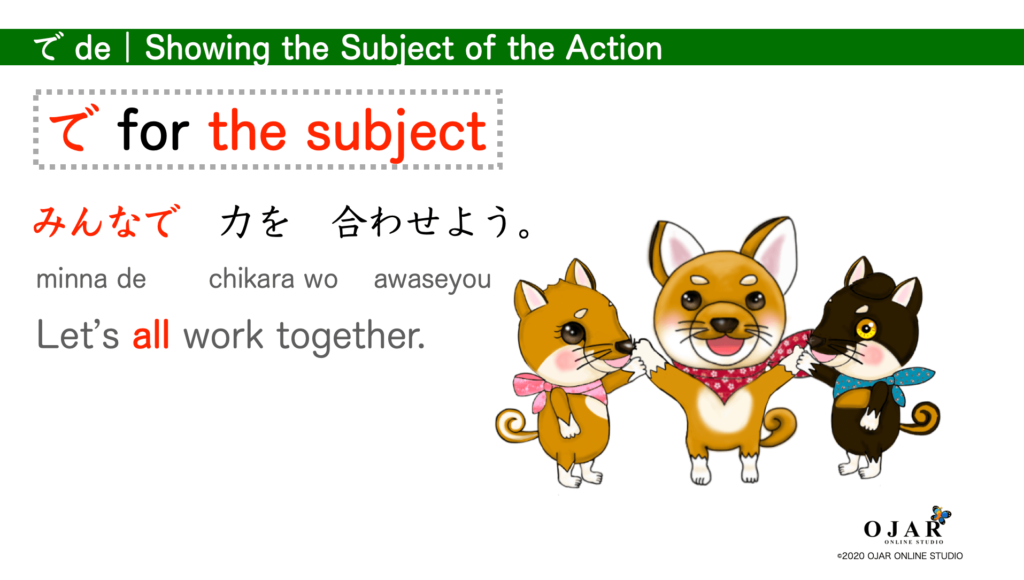
| Japanese | English |
|---|---|
| 自分で jibunde | by myself |
| あなた(自身)で anata(jishin)de | by yourself |
| 彼(自身)で kare(jishin)de | by himself |
| 彼女(自身)で kanojo(jishin)de | by herself |
| 彼ら(自身)で karera(jishin)de | by themselves |
The Most Common Verbs with ni and de
I’m goin to show the most common verbs which you can use with particle ni and particle de depending on the situations here.
・Action Verbs
| Japanese | Usages with ni | Japanese | Usages with de |
|---|---|---|---|
| に 行く ni iku | to go (to place) to go (time) to go (purpose) | で 行く de iku | to go (transportation) to go (period) to go (reason) |
| に 来る ni kuru | to come (to place) to come (time) to come (purpose) | で 来る de kuru | to come (transportation) to come (period) to come (reason) |
| に 帰る ni kaeru | to go back (to place) to go back (time) | で 帰る de kaeru | to go back (transportation) to go back (period) to go back (reason) |
| に 到着する ni touchakusuru | to arrive (place) to arrive (time) | で 到着する de touchakusuru | to arrive (transportation) to arrive (period) |
| に 出発する ni shuppatsusuru | to leave (from place) to leave (time) | で 出発する de shuppatsusuru | to leave (transportation) to leave (period) to leave (reason) |
| に 引っ越しする ni hikkosu | to move (to place) | で 引っ越しする de hikkosu | to move (transportation) to move (period) to move (reason) |
・Motion Verbs
■ School
| Japanese | Usages with ni | Japanese | Usages with de |
|---|---|---|---|
| に 始まる ni hajimaru | to start (time) | で 始まる de hajimaru | to start (in place) to start (period) |
| に 終わる ni owaru | to end (time) | で 終わる de owaru | to end (in place) to end (period) to end (reason) |
| に 遅れる ni okureru | to be late (purpose) | で 遅れる de okureru | to be late (reason) |
| に 勝つ ni katsu | to win (person) to win (purpose) | で 勝つ de katsu | to win (place) to win (means) to win (period) to win (reason) |
| に 負ける ni makeru | to lose (person) to lose (purpose) | で 負ける de makeru | to lose (place) to lose (period) to lose (reason) |
| に 勉強する ni benkyousuru | to study (time) | で 勉強する de benkyousuru | to study (place) to study (means) to study (language) to study (period) |
| に 教える ni oshieru | to teach (person) | で 教える de oshieru | to teach (place) to teach (means) to teach (language) to teach (period) |
■ Business
| Japanese | Usages with ni | Japanese | Usages with de |
|---|---|---|---|
| に 働く ni hataraku | to work (time) | で 働く de hataraku | to work (place) to work (period) to work (reason) |
| に 伝える ni tsutaeru | to tell (to person) to tell (time) to tell (purpose) | で 伝える de tsutaeru | to tell (place) to tell (means) to tell (language) to tell (period) to tell (reason) |
| に 問い合わせる ni toiawaseru | to inquire (person) to inquire (time) to inquire (purpose) | で 問い合わせる de toiawaseru | to inquire (place) to inquire (means) to inquire (language) to inquire (period) to inquire (reason) |
| に 謝る ni ayamaru | to apologize (to person) to apologize (purpose) | で 謝る de ayamaru | too apologize (place) to apologize (means) to apologize (language) to apologize (reason) |
| に 送る ni okuru | to send (to person) to send (to place) to send (time) to send (purpose) | で 送る de okuru | to send (place) to send (means) to send (language) to send (period) to send (reason) |
■ Life
| Japanese | Usages with ni | Japanese | Usages with de |
|---|---|---|---|
| に 開ける ni akeru | to open (time) | で 開ける de akeru | to open (place) to open (means) to open (period) to open (reason) |
| に 閉める ni shimeru | to close (time) | で 閉める de shimeru | to open (place) to close (means) to close (period) to close (reason) |
| に 入れる ni ireru | to put (to place) to put (time) to put (purpose) | で 入れる de ireru | to put (in place) to put (means) to put (period) to put (reason) |
| に 言う ni iu | to say (to person) to say (time) to say (purpose) | で 言う de iu | to say (place) to say (means) to say (language) to say (period) to say (reason) |
| に きく ni kiku に 尋ねる ni tazuneru | to ask (person) to ask (time) to ask (purpose) | で きく de kiku で 尋ねる de tazuneru | to ask (place) to ask (means) to ask (language) to ask (period) to ask (reason) |
| に 書く ni kaku | to write (for person) to write (time) to write (purpose) | で 書く de kaku | to write (place) to write (means) to write (language) to write (period) to write (reason) |
| に 読む ni yomu | to read (for person) to read (time) | で 読む de yomu | to read (place) to read (means) to read ( language) to read (period) to read (reason) |
| に 気づく ni kizuku | to notice (person) to notice (time) to notice (purpose) | で 気づく de kizuku | to notice (place) to notice (means) to notice (period) to notice (reason) |
・Existant Verbs
| Japanese | Usages with ni | Japanese | Usages with de |
|---|---|---|---|
| に 住む ni sumu | to live (in place) to live (time) | で 住む de sumu | to live (means) to live (period) to live (reason) |
| に 泊まる ni tomaru | to stay (in place) to stay (time) | で 泊まる de tomaru | to stay (means) to stay (period) to stay (reason) |
| に 立つ ni tatsu | to stand (by place) | で 立つ de tatsu | to stand (means) to stand (period) to stand (reason) |
| に 座る ni suwaru | to sit (on place) | で 座る de suwaru | to sit (means) to sit (reason) |
| に 掛ける ni kakeru | to hang (on place) | で 掛ける de kakeru | to hang (means) to hang (reason) |
・Passive Verbs
| Japanese | Usages with ni | Japanese | Usages with de |
|---|---|---|---|
| に 招待される ni shoutaisareru | to be invited (by person) to be invited (time) to be invited (purpose) | で 招待される de shoutaisareru | to be invited (place) to be invited (means) to be invited (reason) |
| に 呼ばれる ni yobareru | to be called (by person) to be called (time) to be called (purpose) | で 呼ばれる de yobareru | to be called (place) to be called (means) to be called (reason) |
| に 使われる ni tsukawareru | to be used (by person) to be used (time) to be used (purpose) | で 使われる de tsukawareru | to be used (place) to be used (means) to be used (reason) |
| に 発見される ni hakkensareru | to be found (by person) to be found (time) to be found (purpose) | で 発見される de hakkensareru | to be found (place) to be found (means) to be found (reason) |
| に 期待される ni kitaisareru | to be expected (by person) to be expected (purpose) | で 期待される de kitaisareru | to be expected (place) to be expected (reason) |
・Emotional Verbs
| Japanese | Usages with ni | Japanese | Usages with de |
|---|---|---|---|
| に 心配する ni shinpaisuru | to worry (about purpose) | で 心配する de shinpaisareru | to worry (place) to worry (reason) |
| に 喜ぶ ni yorokobu | to be glad at (time) to be glad at (purpose) | で 喜ぶ de yorokobu | to be glad at (place) to be glad at (reason) |
| に 悲しむ ni kanashimu | to be sad (time) to be sad (about purpose) | で 悲しむ de kanashimu | to be sad (place) to be sad (reason) |
| に 怒る ni okoru | to be angry (with person) to be angry (time) to be angry (about purpose) | で 怒る de okoru | to be angry (place) to be angry (period) to be angry (reason) |
| に 疲れる ni tsukareru | to be tired (of person) to be tired (of purpose) | で 疲れる de tsukareru | to be tired (reason) |
| に 飽きる ni akiru | to be bored (with purpose) | で 飽きる de akiru | to be bored (reason) |
Particle ni vs Particle de QUIZ
Homework
Answers these questions in Japanese and comment below!
1. あなたは どうやって 仕事 / 学校 に行きますか。
2. あなたは どこに 住んでいますか。
Okay, that’s all for today!
Good luck with your Japanese study 😊👍
A Dictionary of Basic Japanese Grammar
| Amazon Reviews: | ★★★★★ |
|---|
Publisher: JAPAN TIMES
Next Lesson is;
Minna no Nihongo 22: Nihongo wo Oshiete Kudasai
Previous Lesson is; CLICK HERE!
Japanese Lesson 19: te-form Is Very Easy!

